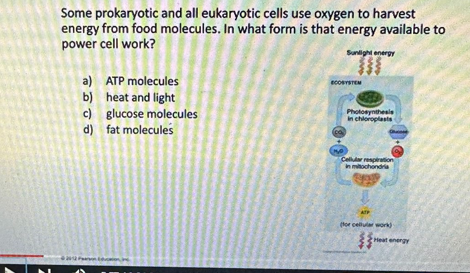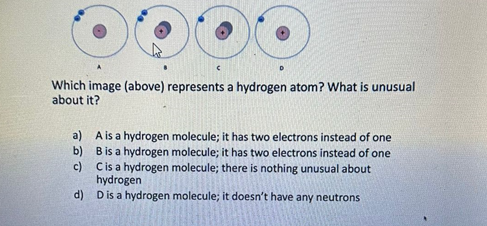Some prokaryotic and all eukaryotic cells use oxygen to harvest energy from food molecules. In what form is that energy available to power cell work? a) ATP molecules heat and light b) c) glucose molecules d) fat molecules Sunlight energy ECOSYSTEM Photosynthesis in chloroplasts Cellular respiration in mitochondria ATP (for cellular work) ww 39 Heat energy
Some prokaryotic and all eukaryotic cells use oxygen to harvest energy from food molecules. In what form is that energy available to power cell work? a) ATP molecules heat and light b) c) glucose molecules d) fat molecules Sunlight energy ECOSYSTEM Photosynthesis in chloroplasts Cellular respiration in mitochondria ATP (for cellular work) ww 39 Heat energy
Human Anatomy & Physiology (11th Edition)
11th Edition
ISBN:9780134580999
Author:Elaine N. Marieb, Katja N. Hoehn
Publisher:Elaine N. Marieb, Katja N. Hoehn
Chapter1: The Human Body: An Orientation
Section: Chapter Questions
Problem 1RQ: The correct sequence of levels forming the structural hierarchy is A. (a) organ, organ system,...
Related questions
Question

Transcribed Image Text:Some prokaryotic and all eukaryotic cells use oxygen to harvest
energy from food molecules. In what form is that energy available to
power cell work?
a)
b)
c) glucose molecules
d) fat molecules
ATP molecules
heat and light
P
Sunlight energy
ECOSYSTEM
Photosynthesis
in chloroplasts
Cellular respiration
in mitochondria
ATP
(for cellular work)
ww
www
Heat energy

Transcribed Image Text:Which image (above) represents a hydrogen atom? What is unusual
about it?
C
a)
A is a hydrogen molecule; it has two electrons instead of one
B is a hydrogen molecule; it has two electrons instead of one
C is a hydrogen molecule; there is nothing unusual about
hydrogen
d)
D is a hydrogen molecule; it doesn't have any neutrons
b)
c)
Expert Solution
This question has been solved!
Explore an expertly crafted, step-by-step solution for a thorough understanding of key concepts.
This is a popular solution!
Trending now
This is a popular solution!
Step by step
Solved in 3 steps

Knowledge Booster
Learn more about
Need a deep-dive on the concept behind this application? Look no further. Learn more about this topic, biology and related others by exploring similar questions and additional content below.Recommended textbooks for you

Human Anatomy & Physiology (11th Edition)
Biology
ISBN:
9780134580999
Author:
Elaine N. Marieb, Katja N. Hoehn
Publisher:
PEARSON

Biology 2e
Biology
ISBN:
9781947172517
Author:
Matthew Douglas, Jung Choi, Mary Ann Clark
Publisher:
OpenStax

Anatomy & Physiology
Biology
ISBN:
9781259398629
Author:
McKinley, Michael P., O'loughlin, Valerie Dean, Bidle, Theresa Stouter
Publisher:
Mcgraw Hill Education,

Human Anatomy & Physiology (11th Edition)
Biology
ISBN:
9780134580999
Author:
Elaine N. Marieb, Katja N. Hoehn
Publisher:
PEARSON

Biology 2e
Biology
ISBN:
9781947172517
Author:
Matthew Douglas, Jung Choi, Mary Ann Clark
Publisher:
OpenStax

Anatomy & Physiology
Biology
ISBN:
9781259398629
Author:
McKinley, Michael P., O'loughlin, Valerie Dean, Bidle, Theresa Stouter
Publisher:
Mcgraw Hill Education,

Molecular Biology of the Cell (Sixth Edition)
Biology
ISBN:
9780815344322
Author:
Bruce Alberts, Alexander D. Johnson, Julian Lewis, David Morgan, Martin Raff, Keith Roberts, Peter Walter
Publisher:
W. W. Norton & Company

Laboratory Manual For Human Anatomy & Physiology
Biology
ISBN:
9781260159363
Author:
Martin, Terry R., Prentice-craver, Cynthia
Publisher:
McGraw-Hill Publishing Co.

Inquiry Into Life (16th Edition)
Biology
ISBN:
9781260231700
Author:
Sylvia S. Mader, Michael Windelspecht
Publisher:
McGraw Hill Education